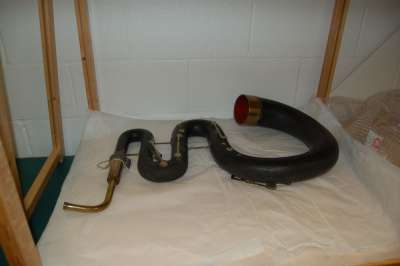Wood-wind instrument
Known as the serpent after its peculiar curved shape, this instrument first emerged in Europe during the early 17th century. Since this time, it has served a wide variety of functions. Although initially confined to orchestral gatherings, by the close of the 18th century, thanks to the influence of King George III, who had a particular fondness for the instrument, the serpent was admitted into military bands. During a parade it would have been held sideways, to avoid the movement of the player’s knees when marching, and the open end would have been turned outwards to increase the tone.
By the early 19th century, the serpent’s role shifted to supporting the voices of church choirs. This example, created between 1810 and 1829, would have served such a function. Until 1836, the instrument was part of the Ashburton Church Band and played by Thomas Baston. It was later sold by Baston’s son in law, Henry Veale, to a Mrs Budds of Totnes. It then passed to Mr W Prescott Row of Surrey, eventually entering RAMM’s collection in 1916.
This serpent consists of a curved wooden body with five simple brass keys and six open finger holes. The keys include leaf-springs and leather pads, whilst the holes have ivory rings. The mouthpiece, created from a wooden cup and angled brass tube, is designed to shift position according to the desired tuning. The wooden cup can be removed from the brass tube, which slides in and out of the main wooden body. The curved angles of the instrument are supported by brass struts, which are screwed to the body. Although sparsely decorated, the instrument features some engraved stringing around each of the brass ends, and its interior is painted red.
By the early 19th century, the serpent’s role shifted to supporting the voices of church choirs. This example, created between 1810 and 1829, would have served such a function. Until 1836, the instrument was part of the Ashburton Church Band and played by Thomas Baston. It was later sold by Baston’s son in law, Henry Veale, to a Mrs Budds of Totnes. It then passed to Mr W Prescott Row of Surrey, eventually entering RAMM’s collection in 1916.
This serpent consists of a curved wooden body with five simple brass keys and six open finger holes. The keys include leaf-springs and leather pads, whilst the holes have ivory rings. The mouthpiece, created from a wooden cup and angled brass tube, is designed to shift position according to the desired tuning. The wooden cup can be removed from the brass tube, which slides in and out of the main wooden body. The curved angles of the instrument are supported by brass struts, which are screwed to the body. Although sparsely decorated, the instrument features some engraved stringing around each of the brass ends, and its interior is painted red.
Object Summary
- Accession Loan No.
- 56/1916
- Collection Class
- Musical instruments
- Material
- woodivorybrassleather
- Common Name
- wood-wind instrument
- Simple Name
- musical instrument
- Period Classification
- George III (1760-1811); Regency (1811-1820)
- Production Town
- London
- Production Country
- United Kingdom: England
- Production Person Surname
- D’Almaine & Co.
- Production Year Low
- 1810
- Production Year High
- 1812


